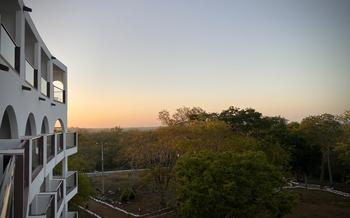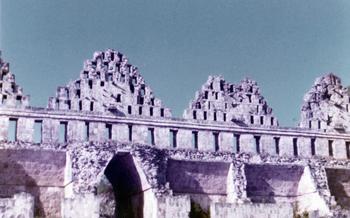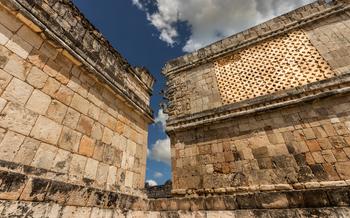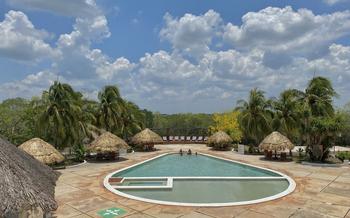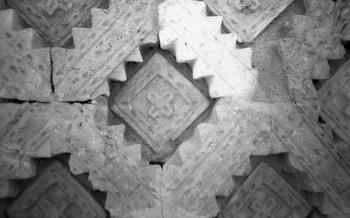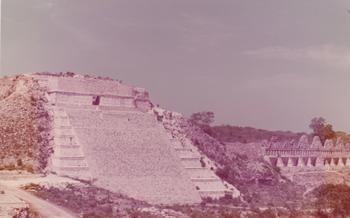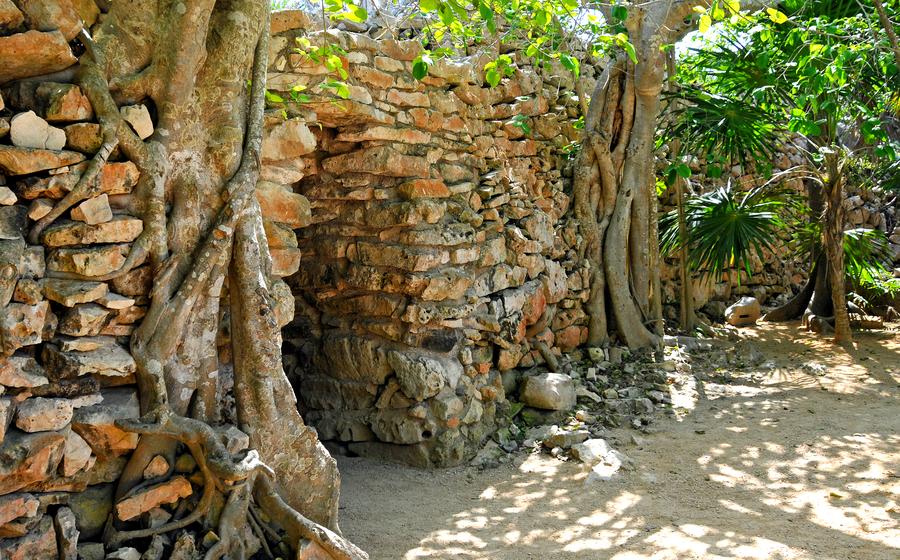
Tulum Archaeological Site
- Uxmal: A Majestic Mayan City in the Yucatan Peninsula
- Discover the Great Pyramid of Uxmal, a Symbol of Mayan Might
- Explore the Nunnery Quadrangle: Elegance and Intricacy in Stone
- Marvel at the Palace of the Governor: A Showcase of Mayan Power
- Climb the Temple of the Magician: A Journey to the Past
- The Ball Court: Witness the Ancient Game of Pok-ta-Pok
- Plaza of the Birds: A Gathering Place for Rituals and Ceremonies
- The House of Turtles: A Place of Mysteries and Legends
- The East Group: A Complex of Architectural Treasures
- The Grutas de Loltún: A Cave Adventure Near Uxmal
- Cenote Xlacah: A Sacred Water Source for the Mayans
- Uxmal Archaeological Museum: Uncovering the Secrets of the Past
- Xpuhil and Kabah: Neighboring Mayan Sites Worth Exploring
- Tips for Visiting Uxmal: A Traveler's Guide
Uxmal: A Majestic Mayan City in the Yucatan Peninsula
Nestled deep within the lush jungles of the Yucatan Peninsula, Uxmal stands as a testament to the ingenuity and architectural prowess of the ancient Mayan civilization. With its towering pyramids, intricate carvings, and well-preserved structures, Uxmal offers a glimpse into the rich cultural heritage and advanced society that once thrived in this region.
The city's name, meaning "thrice built," hints at its long and complex history, with evidence suggesting that Uxmal was continuously inhabited and expanded over several centuries. Its strategic location along ancient trade routes and its access to water sources contributed to its rise as a significant political and economic center.
Uxmal's unique architectural style sets it apart from other Mayan cities. The use of corbelled arches, known as "Puuc style," creates stunning facades and vaulted ceilings that showcase the Mayans' mastery of construction techniques. The intricate carvings and sculptures adorning the buildings depict deities, mythical creatures, and scenes from daily life, providing valuable insights into Mayan beliefs and cultural practices.
For first-time travelers, Uxmal offers an awe-inspiring introduction to the wonders of the Mayan civilization. The city's well-preserved state and its relatively smaller size compared to other sites make it an ideal destination for those seeking a comprehensive and immersive experience of Mayan history and architecture.
Discover the Great Pyramid of Uxmal, a Symbol of Mayan Might
Towering over the ancient city of Uxmal, the Great Pyramid stands as a testament to the architectural prowess and ingenuity of the Maya. Reaching a height of over 35 meters, this colossal structure is a sight to behold, showcasing the intricate details and precision that characterized Mayan construction techniques.
Built during the Late Classic period (600-900 AD), the Great Pyramid, known locally as the Pirámide del Adivino or Pyramid of the Magician, is a marvel of engineering. Its construction required millions of limestone blocks, each carefully quarried, transported, and positioned without the use of mortar or cement. The pyramid's design reflects a deep understanding of astronomy and mathematics, as its alignment with the sun and stars holds significant cultural and religious importance.
The Great Pyramid served as a temple and a royal residence, housing the elite and ruling class of Uxmal. Its numerous chambers and passageways, adorned with intricate carvings and sculptures, provide a glimpse into the rich history and complex rituals that took place within its walls.
The pyramid's legacy extends beyond its physical presence. Its grandeur and symbolism have contributed to a deeper understanding of Mayan civilization, shedding light on their worldview, social hierarchy, and religious beliefs. Today, the Great Pyramid of Uxmal remains an iconic symbol of the Maya and a source of inspiration for scholars and travelers alike.
Explore the Nunnery Quadrangle: Elegance and Intricacy in Stone
Amidst the sprawling ruins of Uxmal, the Nunnery Quadrangle stands out as a testament to the Mayans' exquisite craftsmanship and architectural prowess. This complex of interconnected buildings, arranged around a central courtyard, showcases a unique blend of elegance and intricacy. The name "Nunnery" is a misnomer given by the Spanish due to its resemblance to a cloister, but its true purpose remains a subject of debate among archaeologists.
The Nunnery Quadrangle is renowned for its intricate carvings and sculptures, which adorn the lintels, door frames, and facades of the buildings. These intricate artworks depict a variety of subjects, including mythological creatures, human figures engaged in everyday activities, and scenes from Mayan religious ceremonies. The precision and detail of these carvings are simply breathtaking, reflecting the exceptional artistic skills of the Mayan artisans.
The purpose of the Nunnery Quadrangle is still shrouded in mystery, with various theories suggesting that it served as a palace for the Mayan rulers, a school for the elite, or a ceremonial center. Regardless of its exact function, it's clear that this complex played an important role in the daily life and rituals of the ancient Mayans.
As you explore the Nunnery Quadrangle, take your time to admire the intricate carvings, marvel at the architectural precision, and let your imagination transport you back in time to witness the vibrant culture of the ancient Mayans.
Marvel at the Palace of the Governor: A Showcase of Mayan Power
The Palace of the Governor stands as a testament to the architectural prowess and power of the ancient Maya. This magnificent structure, located on the western side of the Grand Plaza, boasts an impressive facade adorned with intricate carvings, masks, and geometric designs. Its imposing presence reflects the political and administrative importance of Uxmal during its heyday.
One of the most striking features of the Palace of the Governor is its unique architectural style. The building's facade is divided into three sections, with the central section rising higher than the others and featuring a series of arched doorways. These doorways lead into a series of rooms, each with its own unique purpose and function.
The Palace of the Governor is not only a marvel of architecture but also a treasure trove of historical significance. The building was likely used by the city's ruler, or "halach uinic," and his entourage. It served as a center of government, a place for conducting ceremonies and rituals, and a residence for the ruling elite.
The palace has undergone extensive restoration and conservation efforts in recent years, ensuring its preservation for future generations. Archaeological studies of the building have shed light on the construction techniques, materials, and design principles employed by the ancient Maya. This knowledge has contributed to our understanding of Mayan civilization and its sophisticated architectural achievements.
Climb the Temple of the Magician: A Journey to the Past
The Temple of the Magician, also known as the Pyramid of the Magician, stands as a testament to the architectural prowess of the ancient Maya. Towering at an impressive height, this pyramid beckons adventurous travelers to embark on a journey to the past. Despite its challenging climb, the rewards are immense.
As you ascend the steep steps, feel the weight of history beneath your feet. Each stone, weathered by time, holds the secrets of a civilization that thrived centuries ago. The climb may be strenuous, but the panoramic views from the summit make it all worthwhile. Gaze upon the lush green canopy of the Yucatan Peninsula, dotted with other ancient Maya cities, and let your imagination soar.
The Temple of the Magician holds deep historical significance. It was once the tallest structure in Uxmal and served as a place of religious rituals and ceremonies. Its purpose, however, remains shrouded in mystery, adding to its allure. Whether it was a temple for worship, an astronomical observatory, or a symbol of power, the Temple of the Magician invites visitors to ponder the secrets of the Maya.
For those who dare to climb to the top, the Temple of the Magician offers a unique perspective on Uxmal and the surrounding landscape. It's an experience that transports you back in time, allowing you to connect with the ancient Maya in a profound way. So, embrace the challenge, conquer the climb, and discover the magic that awaits you at the summit.
The Ball Court: Witness the Ancient Game of Pok-ta-Pok
Amidst the ancient city of Uxmal, the Ball Court stands as a testament to the Mayans' sporting prowess and cultural traditions. This colossal arena, with its towering stone walls and sloping sides, once hosted the thrilling game of Pok-ta-Pok, a ritualistic contest that held deep religious and social significance.
The Mayans were passionate about this game, which involved two teams using their hips and forearms to maneuver a heavy rubber ball through a stone hoop mounted high on the court walls. The rules were intricate, and the outcome of each match was believed to have divine implications.
Beyond its sporting significance, the Ball Court served as a sacred space for the Mayans. Rituals and ceremonies often accompanied the games, and the court's acoustics amplified the chants and prayers of the spectators. Victories were celebrated with elaborate feasts and offerings to the gods, while defeats were seen as omens that required appeasement.
The Ball Court at Uxmal is a stunning example of Mayan ingenuity and artistry. Its well-preserved condition allows visitors to imagine the fervor and excitement that once filled the air during a Pok-ta-Pok match. As you stand within its walls, you can almost hear the echoes of the ancient players and feel the pulse of a civilization that revered both competition and cooperation.
Plaza of the Birds: A Gathering Place for Rituals and Ceremonies
The Plaza of the Birds, also known as the Plaza del Pájaro, holds a significant cultural and historical place within the ancient Mayan city of Uxmal. This open space served as a central gathering place for various ceremonies and rituals, demonstrating the religious and social importance of the city.
The plaza is characterized by its unique architectural features, including a series of low platforms arranged around a central courtyard. These platforms were likely used by priests and other officials to conduct ceremonies, while the courtyard provided space for the community to gather and participate.
The name "Plaza of the Birds" derives from the intricate carvings that adorn the buildings surrounding the plaza. These carvings depict a variety of birds, including parrots, macaws, and toucans, which held symbolic meanings in Mayan mythology. Birds were associated with the sky, the sun, and the underworld, and their presence in the plaza suggests that this space was used for ceremonies related to these realms.
In addition to its religious significance, the Plaza of the Birds also played a role in daily life in Uxmal. Market vendors would set up stalls in the plaza, selling goods such as food, pottery, and textiles. The plaza was also a place for people to socialize and exchange news and information.
The House of Turtles: A Place of Mysteries and Legends
Amidst the grandeur of Uxmal, the House of Turtles stands as a captivating enigma, its unique architectural features sparking curiosity and imagination. Constructed on a raised platform, the building exhibits a striking turtle-shaped roof, a distinctive characteristic that sets it apart from other structures within the ancient city.
The House of Turtles holds a profound cultural significance, deeply rooted in Mayan mythology. Turtles were revered as symbols of fertility, creation, and the underworld, representing the connection between the earthly realm and the spiritual world. The building's design and ornamentation reflect this sacred symbolism, inviting visitors to delve into the rich tapestry of Mayan beliefs and traditions.
Archaeological findings within the House of Turtles have revealed intriguing clues about its purpose and significance. Excavations have uncovered numerous artifacts, including ceramic vessels, jade ornaments, and skeletal remains, suggesting that the structure may have served as a mortuary temple or a place of ritualistic ceremonies related to death and rebirth.
The House of Turtles continues to captivate visitors with its enigmatic aura, inspiring theories and speculations about its exact function. Whether it served as a sacred temple, a burial site, or a combination of both, this ancient structure remains a testament to the ingenuity, creativity, and spiritual beliefs of the Mayan civilization.
The East Group: A Complex of Architectural Treasures
In addition to the main attractions, Uxmal boasts an impressive collection of structures known as the East Group. Located to the east of the Grand Pyramid, this complex showcases a diverse array of architectural styles and designs. Among the notable structures within the group are the Great Temple, the Palace of the Turtles, and the House of the Birds.
The Great Temple is a stepped pyramid similar in design to the Pyramid of the Magician but smaller in size. It stands as a testament to the architectural prowess of the ancient Mayans, with its intricate carvings and well-preserved facade.
The Palace of the Turtles is renowned for its unique facade adorned with rows of carved turtle shells. These intricate carvings symbolize fertility and abundance, and they have become an iconic symbol of Uxmal. The palace is believed to have been the residence of high-ranking officials or priests and served as an administrative center.
The House of the Birds is a smaller structure located near the Palace of the Turtles. It features a distinctive facade with bird-shaped motifs and is thought to have been used for religious ceremonies or as a meeting place for the elite.
The East Group also includes several other smaller structures, each with its own unique features and significance. Together, they form a captivating complex that offers a glimpse into the architectural diversity and cultural richness of the ancient Mayan civilization.
The Grutas de Loltún: A Cave Adventure Near Uxmal
Immerse yourself in the subterranean wonders of the Grutas de Loltún, a mesmerizing cave system located just a short drive from the ancient city of Uxmal.
Journey into the heart of the Yucatan Peninsula's karst landscape and discover a realm of stalactites, stalagmites, and crystalline formations that have been shaped over millennia by the relentless forces of water and time. Explore this vast underground network of chambers, tunnels, and cenotes, each revealing its own unique beauty and secrets.
Delve into the history of the Grutas de Loltún, which served as a sacred place for the ancient Mayans. Archaeological evidence suggests that these caves were used for ceremonial purposes, with remnants of pottery, tools, and even human remains found within their depths.
Don't miss the opportunity to swim in the crystal-clear waters of Cenote Xlacah, a natural pool located within the cave system. This refreshing oasis provides a welcome respite from the heat and humidity of the Yucatan Peninsula, offering a chance to cool off and marvel at the beauty of the surrounding rock formations.
For a truly unforgettable experience, embark on a guided tour of the Grutas de Loltún. Knowledgeable guides will lead you through the caves, sharing stories and insights about their geological and cultural significance. Whether you're a seasoned spelunker or a first-time cave explorer, the Grutas de Loltún offer an adventure that will leave you in awe.
Cenote Xlacah: A Sacred Water Source for the Mayans
Immerse yourself in the mystical allure of Cenote Xlacah, an ancient natural wonder that held profound spiritual and practical significance for the Maya civilization.
Nestled within the lush vegetation surrounding Uxmal, Cenote Xlacah beckons with its crystal-clear waters and captivating history. As a sacred water source, it served as a vital lifeline for the Maya people, providing them with a reliable water supply during dry seasons and functioning as a ceremonial site for rituals and offerings.
Take a refreshing dip in the cenote's refreshing waters, allowing the tranquility of the surroundings to envelop you. Snorkelers and divers can explore the underwater world, discovering ancient artifacts and marveling at the intricate cave systems and rock formations that lie beneath the surface.
Beyond its practical importance, Cenote Xlacah held deep cultural and religious significance for the Maya. It was believed to be a gateway to the underworld, a place where the spirits of the deceased resided. Offerings were made to appease these spirits, ensuring their safe passage and continued protection of the living.
Conservation efforts are underway to protect and preserve this sacred site, ensuring that future generations can appreciate its beauty and historical significance. Visitors are encouraged to respect the delicate ecosystem and contribute to its conservation by following designated trails, avoiding touching or disturbing the rock formations, and refraining from using harsh chemicals or sunscreen that could harm the water quality.
Cenote Xlacah offers a unique opportunity to connect with the spiritual and cultural heritage of the Maya civilization. Whether you choose to swim, snorkel, or simply soak in the tranquil atmosphere, this sacred water source promises an unforgettable and enriching experience.
Uxmal Archaeological Museum: Uncovering the Secrets of the Past
Located within the archaeological site of Uxmal, the Uxmal Archaeological Museum is a treasure trove of knowledge and insights into the ancient Maya civilization. Easily accessible for visitors, the museum houses a collection of artifacts, exhibits, and displays that provide a comprehensive overview of the history, culture, and daily life of the Maya people.
The museum's collection includes intricate pottery, jade ornaments, stone tools, and other artifacts excavated from the site and surrounding areas. These artifacts offer a glimpse into the artistry, craftsmanship, and technological advancements of the Maya. Interactive displays and informative panels explain the significance of each artifact and its role in Mayan society.
One of the highlights of the museum is the replica of the famous Chacmool sculpture, a reclining figure with a bowl on its stomach. The original sculpture, discovered at Uxmal, is now housed in the National Museum of Anthropology in Mexico City. The replica at the Uxmal Archaeological Museum allows visitors to appreciate the intricate details and symbolism of this iconic Maya artifact.
The museum also features a scale model of the entire Uxmal site, providing visitors with a comprehensive understanding of the layout and relationships between the different structures. This model helps visualize the grandeur and complexity of the ancient city.
A visit to the Uxmal Archaeological Museum is a valuable addition to any tour of the Uxmal ruins. It enhances the understanding of the site's significance and provides a deeper appreciation for the rich cultural heritage of the Maya civilization.
Xpuhil and Kabah: Neighboring Mayan Sites Worth Exploring
Uxmal's allure extends beyond its own boundaries, as it is surrounded by other captivating Mayan ruins that offer a glimpse into the region's rich history. Xpuhil, located just 12 miles (19 kilometers) southeast of Uxmal, boasts a unique architectural style characterized by intricate stone carvings and well-preserved structures. Highlights include the Temple of the Masks, adorned with numerous human faces, and the Palace of the Governors, showcasing impressive vaulted ceilings.
Kabah, situated 18 miles (29 kilometers) north of Uxmal, is another must-visit destination. Its name translates to "the hand-worked place," reflecting the remarkable craftsmanship evident in its buildings. The highlight of Kabah is the Codz Poop, a large palace featuring a unique facade decorated with masks of the rain god Chaac.
Visiting Xpuhil and Kabah offers a chance to explore the diversity of Mayan architecture and learn about the connections between these ancient cities. Whether you choose to embark on a day trip or incorporate them into a broader itinerary, these neighboring sites will undoubtedly enrich your understanding of the Mayan civilization.
Tips for Visiting Uxmal: A Traveler's Guide
For the best experience at Uxmal, plan your visit during the shoulder months (May-June and September-October) to avoid the peak tourist season. This way, you can enjoy the ancient city without the crowds and take your time exploring its wonders.
Come prepared with comfortable clothing and sturdy shoes suitable for walking on uneven surfaces. A hat, sunglasses, and sunscreen are essential for protection against the tropical sun. Bring a refillable water bottle to stay hydrated, as there are limited options for purchasing drinks within the archaeological site.
Consider joining a guided tour to gain insights into the history and significance of Uxmal. These tours are led by knowledgeable guides who can provide fascinating stories and explanations about the ancient Mayan civilization. Alternatively, you can opt for self-guided exploration using a guidebook or downloadable app.
To reach Uxmal, you can rent a car for flexibility or take a bus from the nearby city of Mérida. Once inside the archaeological site, follow the designated paths and signs to navigate the ruins safely. Be respectful of the historical significance of the site and refrain from climbing or touching the structures.
Plan to spend at least half a day at Uxmal to fully appreciate its wonders. Allow ample time to wander through the various plazas, climb the Temple of the Magician, and explore the intricate carvings and sculptures that adorn the buildings. Take breaks to rest, hydrate, and soak in the beauty of your surroundings.
